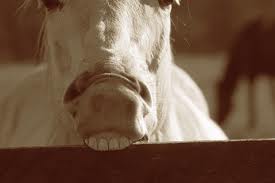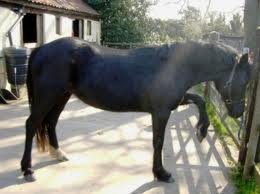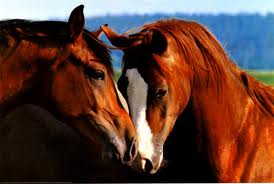|
Equine Behavior problems / Vices
Abnormal Horse Behavior Animal behavior experts often refer to vices (bad habits) as stereotypies because they are often rooted in the behavioral nature of the animal. Understanding that vices are behaviorally based may assist in preventing and/or treating these equine behavior problems.
Common vices are described below
Cribbing This term is sometimes confused with wood chewing; however, cribbing is more serious. It involves the grasping of a surface (often wood) with the teeth and swallowing air. It is unclear if there is a single cause or if there is an interaction of several variables that causes the behavior. This equine behavior problem can cause horses to lose weight, wear down their top incisors, and be more prone to colic.

Cribbing can be destructive to the horse as well as facilities. Correcting behavioral vices can be difficult. Punishment is almost never effective and may actually worsen the condition. Try to determine the basis for the problem. For example, if the horse is chewing the planks on the stall because of a lack of fiber in the diet, simply feed it more hay or a lower-quality hay with more fiber. If the horse is chewing because of simple boredom, provide stimuli, such as stall balls or other safe toys to decrease the boredom and the wood chewing. It is also sometimes effective to put up a barrier such as metal flashing, over the favorite chewing place, or to use a deterrent such as hot pepper sauce on the wood. Sometimes a simple change can prevent wood chewing. Moving the horse to a different stall or allowing more pasture time may help this equine behavior problem.
Cribbing is even harder to correct, but it is more important to find the solution, because it is potentially more dangerous to the horse. Sometimes, a cribbing strap placed around the throat will make swallowing difficult enough that it curbs the habit. A grazing muzzle that allows grazing and drinking but prevents cribbing may also help.

Stall kicking This behavior involves a horse habitually kicking or pawing the walls and/or floor of its stall. This behavior often intensifies whenever someone is in the barn in at attempt to get attention and food. Overfeeding, and lack of exercise may make a horse a prime candidate for developing any of a number of stable vices. Weaving The shifting of the horse’s body from side to side is another equine Behavior problem. Circling and head bobbing are self-descriptive. All of these and other habitual movements may simply be annoying or may become so persistent that they actually result in a tired and listless animal. Sometimes horses that are developing a tendency toward weaving, circling, or other repetitive movement vices will stop the behavior if you simply introduce a companion animal in their stalls, enable them to get more exercise, or turn them out periodically into an open paddock or pasture.
•Horses are strongly social. They are herd animals and are very comfortable when they can see other horses.
•Horses are herbivores, or plant-eating animals. They rely on grazing grasses and leaves for food.
•Horses typically show a tendency for imitation between young and old.
•Horse are seasonal breeders.
•Males tend to form separate male subgroups at certain times of the year.
•Horses are considered a prey species in the animal kingdom.
•Horses are capable of strong pair bond relationships.
Source - A. Griffin, C. McCall, B. Greene, Equine behavior Specialist
Return from Equine Behavior problems to Horse Riding Connection
|

